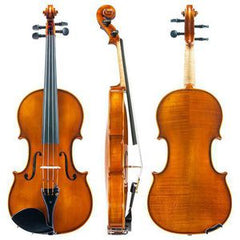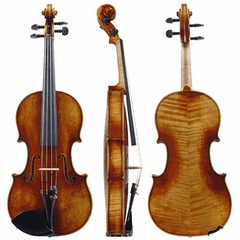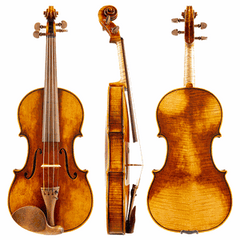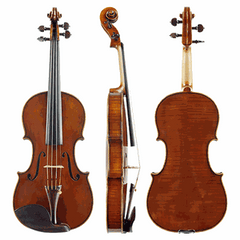BOOK AN APPOINTMENT
Book an Appointment

 Over the last 30 years we have gathered feedback from players and teachers to help categorise our violins according to the level of ability of the player.
Over the last 30 years we have gathered feedback from players and teachers to help categorise our violins according to the level of ability of the player.While there is no right or wrong when it comes to buying a violin, for your convenience we have put each of our cellos into the categories of beginner, intermediate, advanced and professional in order to help you align the capabilities of your instrument with your goals. Which one is right for you? Read on to find out!
These violins are designed to get you started and are typically suitable for the first few years of playing. They are mostly made in China in a production line but are carefully selected and set up by our team in Sydney. We work very closely with our Chinese partners and regularly visit them to help with training and quality control.
In this range we focus on functionality and ease of playing. It is tough making a nice sound when you are just getting started, so our beginner violins are often designed to have a ‘forgiving’ sound. The sound is often described as smooth and warm. The aim is to make it easy to produce a ‘nice’ sound until you develop your technique and increase your confidence. We also focus on the set up and functionality of the violin.
All violins are set up by our in-house luthiers with an easy action to make it more comfortable for your left hand and they typically all come with fine tuners in the tailpiece to make it easier to tune. There’s no right or wrong when it comes to how long they will last however based on our experience you will start to outgrow a beginner violin once you reach around AMEB grade four.
Budget approximately $400-$1000

A Kreisler #120 Beginner Violin Outfit
One of our most popular beginner violins
Shop Beginner Violins
If you’ve been playing consistently and making progress for a few years it is likely that you will be ready for an intermediate violin. Intermediate violins are typically either made in China, mostly by hand in smaller workshops, or are made in a production line in Germany. All violins are shipped to Australia where we do the final set up and assembly.
When you reach an intermediate level you typically require more dynamic variation and tone colours to express yourself musically. It isn’t possible to get a violin that does everything in this range however you start to be able to have a choice between violins that are ‘warmer’ and violins that are ‘brighter’. As a rule of thumb, we have found that German violins in this range tend to be more on the warmer side whereas Chinese violins tend to be brighter but there are of course many exceptions to this rule.
We typically find that our customers naturally have a preference when they hear the difference. Some of our customers buy an intermediate violin as their first violin if they are after a more sophisticated sound than what is achievable with a beginner violin. We have found that our intermediate violins can comfortably perform well at an AMEB grade 4-7 standard. Around grade 7-8 we find many players start looking to upgrade to an advanced instrument.
Budget approximately $1000-$4500

A Glanville & Co Nullarbor N20
One of our most popular Intermediate Violins
Shop Intermediate Violins
If you’ve been playing for many years and are looking to do AMEB grade 8 and above, then you’ll probably find what you’re looking for in our advanced range of violins. Violins in this range are made exclusively in Germany and France. We work with small workshops producing quality instruments to a high standard.
We also offer used and antique instruments, sometimes these could be over 100 years old! Our advanced range of violins offer a wider range of tonal colours and often project much better than our intermediate violins making them perfect for players moving into their diploma levels. In this range, makers can spend more time ‘tuning’ the top and back plates of the violin in order to create a desired sound outcome, which could be warmer, brighter or deeper depending on the maker.
In the advanced range we start to see more experience makers get involved in the design and making process. Many of our customers invest in an advance violin in the later years of high school if violin is a priority in the life of that student. Paired with a good bow, it is often purchased to last a lifetime unless the player goes on to play professionally or at a tertiary level.
Budget approximately $4,500-$10,000

A Glanville & Co Barossa B40 Violin
One of our most popular advanced violins
Shop Advanced Violins
There are many reasons why you might decide to buy a professional violin (sometimes called fine violins). The most common reason is that you have progressed above and beyond a diploma level. In the AMEB system these are the grade above 8th grade and include the Amusa and Lmusa diplomas.
We typically see players making an investment in a professional violin if they are playing at a high standard in the final years of high school with plans to play professionally or at a tertiary level after school. The technical demands on the violin at this level are quite high. The players need to clearly communicate themselves musically through their instrument and it is very difficult to do this on cheaper instruments.
You may also choose to look at a professional violin because you are after a specific type of sound, look or feel. Many amateur chamber musicians still invest in a professional violin in order to achieve the sound they are after.
Violins in our professional range are typically made by one maker at a time or by a small collective of makers. They may come from anywhere in the world but typically they come from Germany, France, Italy, USA and Australia and in many cases it is possible to have direct communication with the maker. There are also many options for antique instruments from many famous makers.
Budget $10,000.00+




An Ettore Soffritti 1911 Violin (Italy)
Doug Glanville is the managing director of The Sydney String Centre. A cellist since the age of 4, he is passionate about music education and seeing his customers succeed with music.
The Sydney String Centre sits on the unceded lands of the Gamaragal people. We pay our respects to Elders and communities past, present, and emerging. We celebrate the stories, culture and traditions of Aboriginal and Torres Strait Islander people who also work and live on this land.
